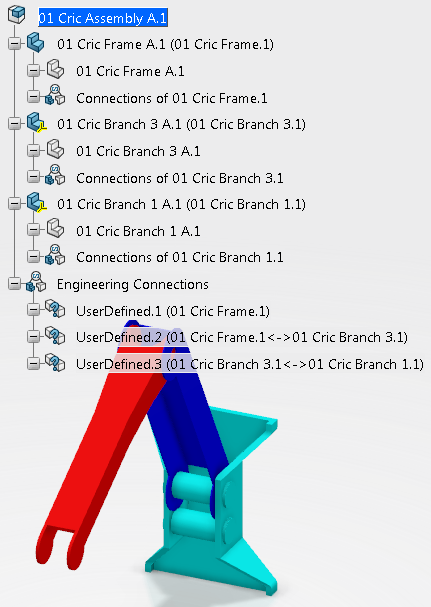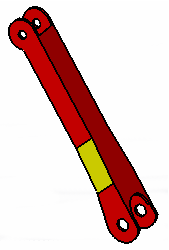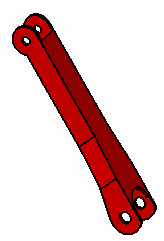Filtering a Product | ||
| ||
-
To filter a product like this one:

-
From the
IP Protection section of the
action bar,
click
Product Filtering
 .
.
- Select the product node.
This product can be:
- A product with a non-shareable representation.
- A product with a shareable representation.
- A 3D Part.
-
From the
IP Protection section of the
action bar,
click
Product Filtering
- Enter an identification string on the right of the product name.
-
Click the arrow to expand the dialog box.
The result product contains products of the same types as those found in the input product :
- The product with a non-shareable representation is transferred as a product with a non-shareable representation.
- The product with a shareable representation is transferred as a product with a shareable representation.
- The 3D Part is transferred as a 3D Part.
-
Optional: Under
In product and representation, select the
Attributes check box.
This option applies to the Reference tab of the properties.
- When Attributes is not selected, only the identification attributes are transferred in the result objects (the Identification string is taken into account).
- When
Attributes is selected
- All the attributes are transferred in the result objects (the Identification string is taken into account).
- Extensions related to AEC Specializations are kept.
-
Optional: Under
In representation, select the
Colors check box, then the required option.
When you select Colors, the dialog box expands automatically to display possible options.
Note: Graphic attributes other than color and transparency (line type, thickness, symbol, ...) are copied with their default value regardless of the status of this option.- Overloaded faces: This option
overrides the standard behavior for colors, transparency and applicative
attributes, and keeps the visual aspect of the original data. For example, if
the color of one face has been changed like this

the result of the transfer looks the same.Notes:- Be aware that this option may be time consuming.
- If a body is not up-to-date (update mask displayed in the tree), the color of the subelements will not be kept, even if this option is selected.
- When the color or the opacity of a subelement has been overloaded (at the level of the subelement or at the level of one of its parents), in the result part, the overloaded color or opacity is kept on the subelement, but can be changed at the level of the subelement only, not at that of its parents. If you overload the color or opacity of one of its parents, the color or opacity of the subelement will not change.
- Container: The whole transferred solid
takes the color and transparency of the original body.

- When
Colors is not selected, the result takes the
default color and transparency.

- Overloaded faces: This option
overrides the standard behavior for colors, transparency and applicative
attributes, and keeps the visual aspect of the original data. For example, if
the color of one face has been changed like this
- Optional: Select the Layers and filters definition check box to transfer layers definition (layer number and name), filters definition (filter name and definition) and the current filter and layer.
-
Optional: Select the
Keep annotations check box to transfer
3D Tolerancing & Annotation
data (FTA) and 3D Tags from
Generative Shape Design
found in the shape representation of the product to filter.
-
Optional: Select the
Contains the string check box to restrict
the filtering process to
3D Tolerancing & Annotation
captures with a name containing a string you provide.
- If you leave the string empty or undefined, all the 3D Tolerancing & Annotation features are transferred.
- The names of the Geometrical Links features of the
transferred
3D Tolerancing & Annotation
features (that are displayed in the
Connection Management dialog box) are
partially kept:
- The names of Group Of Surfaces and User Surface features are kept.
- The names of Geometric Component features are not kept, and are replaced by a default name in the result product.
- In addition, the transferred 3D Tolerancing & Annotation features are displayed in the tree with the same names as in the original product and in the exact same order.
- You will be asked to propagate the original product after having filtered is using the Keep annotations. Do not propagate the product, unless you have made modifications.
See About the Filtering of 3D Tolerancing & Annotation for more information.
-
Optional: Select the
Contains the string check box to restrict
the filtering process to
3D Tolerancing & Annotation
captures with a name containing a string you provide.
-
Optional: Select the
Publications check box.
The publications of the original product are transferred to the result product. The resulting publication points to the resulting geometry, i.e. a publication of publication becomes a publication of the final geometry.
- Optional: Select the Selection sets check box to transfer them.
-
Optional: Select the
Keep 2D Layout for 3D Design data check box to
transfer them.
Note: 2D Layout for 3D Design data can be processed only if they can be visualized in the work area. 2D Layout for 3D Design data that are in No-show in the origin product are transferred and are in No-show in the result product.
- In the case of a global transfer (all options are selected), 2D Layout for 3D Design data will be reconnected to the elements that were pointed, with the exception of 2D profiles generated from 2D geometry of 2D Layout for 3D Design views that are no longer linked to filtered geometry. In particular, 2D Layout for 3D Design filters will be transferred and filtered objects will be correctly managed in result product. No difference will be visible on resulting 2D Layout for 3D Design visualization.
- In the case of a partial transfer (some options are not selected), 2D Layout for 3D Design data will be totally transferred, but some 2D Layout for 3D Design objects will point to non transferred objects (e.g. non transferred annotations cannot be pointed by transferred 2D layout filters).
- All objects (sheets, views, 2D component references and 2D component instances, 2D geometries, annotations, layout filters etc) will be transferred and visible but in some cases objects will be isolated (e.g. annotations that cannot be rerouted on a transferred object). Layout filters, for example, will have the same visible effect, even if a filtered object is not transferred (e.g. de-activated or hidden objects). Non transferred objects will be removed from transferred filters.
- As 3D data and 2D data are transferred in separate steps, profiles in 3D generated from 2D geometry in 2D Layout for 3D Design will be isolated from their 2D geometry in 2D layout after filtering.
- All texts are isolated (no more attribute links). In particular, texts under views with scale factor will lose that scale factor.
- Links to the catalog of details are kept after filtering.
Tips: - To prevent the creation of a product with corrupted data, when part of the 2D Layout for 3D Design data cannot be transferred correctly, an error occurs and no product is created.
- The update status of 2D Layout for 3D Design objects (layout, sheet, view) may change is some cases. For example, if a view is associated to a 3D plane, the corresponding view in the result product will not be up-to-date as the association has been re-created with new 3D plane.
- Curvilinear dimensions with Offset or Parallel representation modes do not support isolated state. As a consequence, rather than turning to isolated analysis display color, they turn to not-up-to- date analysis color.
-
Optional: Select the
Material check box to transfer the material
information.
Material applied to faces is not taken into account.
All Core materials of the origin product that have been applied to product reference, product representation instance (3D shape) and features in a 3D Shape (body, 1D, 2D and 3D elements) are kept.All Covering material of the origin product that have been applied to product reference, product instance or occurrence and product representation instance or occurrence (3D shape) are kept.
-
Optional: Select the
Specifications of sketches check box.
- When this option is not selected, the sketch is transferred As Result. The resulting sketch is not editable.
- When this option is selected, the sketch is transferred
As specified in Part document:
- The resulting sketch is editable.
- The sketch support positioning is switched to isolated definition mode.
- The sketch parameterization and all its associativity with
external features is removed:
- Constraints and their formulas
- Output and output profile features
- All construction geometries
- All geometries in NoShow.
- Use-edges (projections, intersection, ...) are isolated and converted to sketched curves.
- In the case of used-edges with a complex curve mark, the wire isolation cannot keep the sub-element naming, nor the previous orientation of the curves.
-
Optional: Select a Visualization Filtering
option.
- Visible Instances Only
- Visible Features Only
- Visible Geometry Only
- If an instance, feature or a geometry is at least partially visible from a number view points controlled by accuracy values, the instance, feature or the geometry is kept in the result product.
- If an instance, feature or a geometry is completely hidden, it is removed from the result product.
Note: This option detects small faces, and may be time consuming. - Accuracy (Low, Medium, High, Very High) controls the number of view points to consider an element as visible or not. Low provides fewer view points, Very High much more. Medium is the default value.
-
Click
OK.
A new product is created.

Note: This product contains products of the same types as those found in the input product :- The product with a non-shareable representation has been transferred as a product with a non-shareable representation.
- The product with a shareable representation has been transferred as a product with a shareable representation.
- The 3D Part has been transferred as a 3D Part.